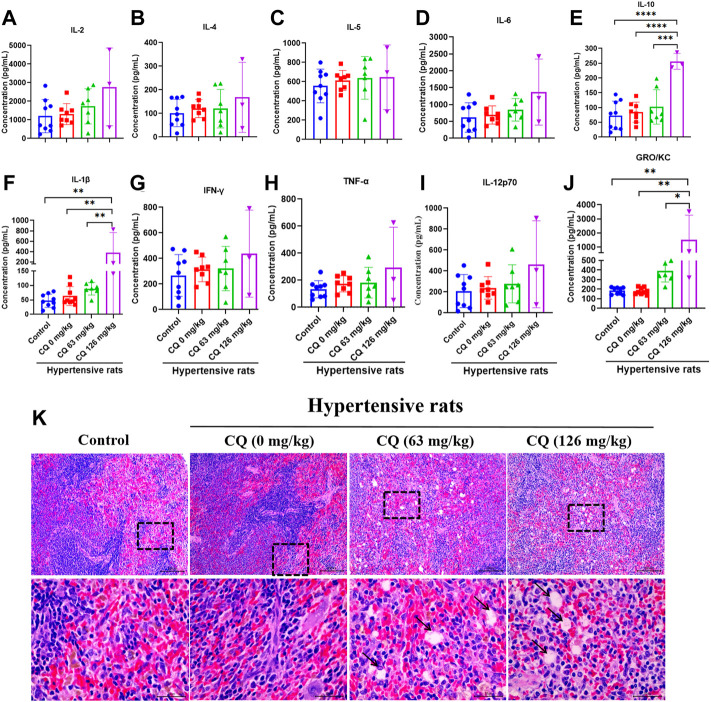Hypertension related toxicity of chloroquine explains its failure against COVID-19: Based on rat model
COVID-19;新冠研究;toxicity;毒理病理;10因子;大鼠10因子 LabEX支持文献- Front Pharmacol
- 2022
- 5.988
- 2022 Nov 30;13:1051694.
- Human
- Luminex
- 毒理/病理
- Serum
- 循环系统
- 高血压
- TNF-α,IFN-γ,IL-1β,IL-4,IL-6,IL-2,IL-5,GRO/KC,IL-12p70x,IL-10
Abstract
LabEx Luminex平台助力氯喹治疗COVID-19的潜力探索
本周为大家带来的文献为发表于Front Pharmacol (IF: 5.6)的” Hypertension related toxicity of chloroquine explains its failure against COVID-19: Based on rat model”。本文使用了LabEx提供的Luminex检测服务。
氯喹(CQ)是一种 4-氨基喹啉药物,长期以来被广泛用于控制疟疾和某些自身免疫性疾病,包括类风湿性关节炎和系统性红斑狼疮。此外,高血压等合并症也可能导致治疗失败。在治疗高血压患者 SARS-CoV-2 感染所需的剂量下,氯喹的安全性和毒性仍然未知。在此,为了研究这些影响,我们对高血压大鼠进行了氯喹的安全性评估,剂量为批准剂量(63 毫克/千克)和高剂量(126 毫克/千克)。结果解释了氯喹作为 COVID-19 治疗失败的原因,并强调了对氯喹进行安全评估和医疗监管的重要性,以避免对患者,尤其是高血压患者造成伤害。
LabEx提供的Luminex检测服务:
为了进一步研究 CQ 对大鼠血清中细胞因子水平的影响,在 Luminex xMAP(多分析物谱分析仪)上使用多重免疫测定法分析了多种细胞因子(TNF-α、IFN-γ、IL-1β、IL-4、IL-6、IL-2、IL-5、GRO/KC、 IL-12p70和IL-10)的多重免疫分析,该分析是在Luminex xMAP仪器上检测十种细胞因子(大鼠经典炎症因子组合)。
血清炎症细胞因子分析(图 8A-J)显示,与对照组和高血压组大鼠相比,高剂量 CQ(而非批准剂量 CQ)可升高 IL-10(p < 0.001 和 p < 0.0001)、IL-1β(p < 0.01)和 GRO/KC (p < 0.05 和 p < 0.01)的水平。然而,高血压大鼠血清中 IL-2、IL-4、IL-5、IL-6、IFN-γ、TNF-α 和 IL-12p70 的水平在暴露于两种剂量的 CQ 后没有发生变化。

在 CQ 处理后,收集健康大鼠和高血压大鼠的血清,分析多种炎症细胞因子的水平,包括 IL-2、IL-4、IL-5、IL-6、IL-10、IL-1β、IFN-γ、TNF-α、IL-12p70 和 GRO/KC。
重要发现:
- 致命性增加:确定氯喹(CQ)在批准剂量(63 mg/kg)和高剂量(126 mg/kg)下,显著增加高血压大鼠的死亡率,分别达到2%和100% 。
- 体重和饮食摄入减少:氯喹暴露期间,高血压大鼠的体重、食物和水的摄入量显著减少 。
- 心脏毒性:氯喹引起高血压大鼠QTc间期延长、乳酸脱氢酶(LDH)和肌酸激酶(CK)升高以及心肌的组织病理损伤 。
- 眼部毒性:高血压大鼠出现眼部出血和视网膜损伤的眼部毒性 。
- 肠道毒性:高血压大鼠出现肠壁变薄和出血内容物的肠道毒性,以及空肠的组织病理变化 。
- 肝毒性:氯喹引起高血压大鼠血清谷丙转氨酶(ALT)升高和肝细胞空泡化 。
- 肾毒性:高剂量氯喹处理的高血压大鼠出现尿液分析和肾功能改变的肾毒性 。
- 免疫状态改变:高剂量氯喹处理的高血压大鼠中,血清IL-10、IL-1β和GRO升高,以及脾脏中度损伤 。
- 对COVID-19治疗失败的解释:研究表明氯喹在COVID-19治疗中的失败原因部分归因于其在高血压大鼠中的多种毒性反应,强调在使用氯喹治疗时需要进行安全性评估和医学监督,尤其是对于高血压患者 。
本网站销售的所有产品及服务均不得用于人类或动物之临床诊断或治疗,仅可用于工业或者科研等非医疗目的。







 沪公网安备31011502400759号
沪公网安备31011502400759号
 营业执照(三证合一)
营业执照(三证合一)


